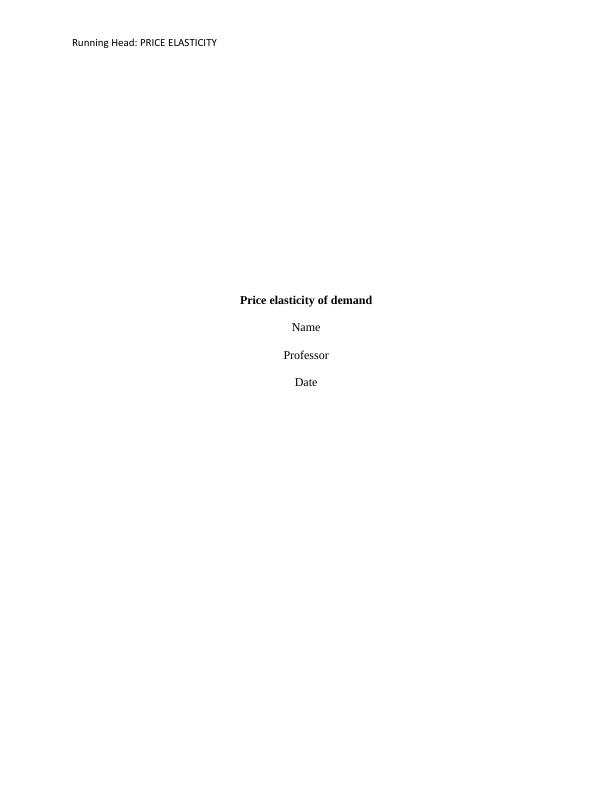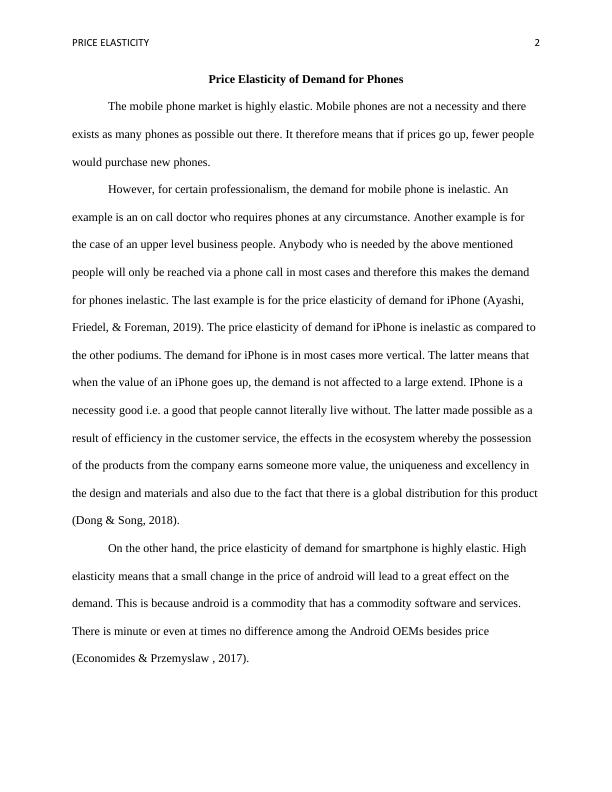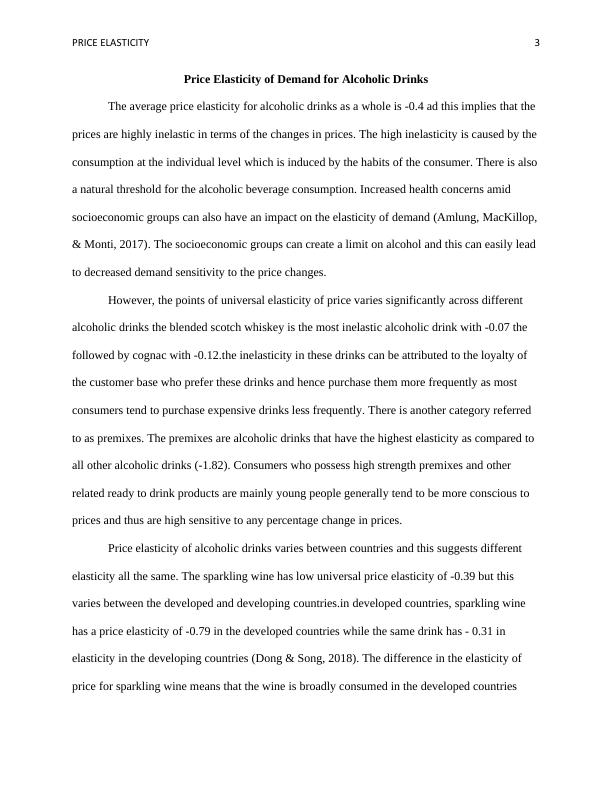Price Elasticity of Demand
Added on 2023-01-19
7 Pages1551 Words56 Views
Running Head: PRICE ELASTICITY
Price elasticity of demand
Name
Professor
Date
Price elasticity of demand
Name
Professor
Date

PRICE ELASTICITY 2
Price Elasticity of Demand for Phones
The mobile phone market is highly elastic. Mobile phones are not a necessity and there
exists as many phones as possible out there. It therefore means that if prices go up, fewer people
would purchase new phones.
However, for certain professionalism, the demand for mobile phone is inelastic. An
example is an on call doctor who requires phones at any circumstance. Another example is for
the case of an upper level business people. Anybody who is needed by the above mentioned
people will only be reached via a phone call in most cases and therefore this makes the demand
for phones inelastic. The last example is for the price elasticity of demand for iPhone (Ayashi,
Friedel, & Foreman, 2019). The price elasticity of demand for iPhone is inelastic as compared to
the other podiums. The demand for iPhone is in most cases more vertical. The latter means that
when the value of an iPhone goes up, the demand is not affected to a large extend. IPhone is a
necessity good i.e. a good that people cannot literally live without. The latter made possible as a
result of efficiency in the customer service, the effects in the ecosystem whereby the possession
of the products from the company earns someone more value, the uniqueness and excellency in
the design and materials and also due to the fact that there is a global distribution for this product
(Dong & Song, 2018).
On the other hand, the price elasticity of demand for smartphone is highly elastic. High
elasticity means that a small change in the price of android will lead to a great effect on the
demand. This is because android is a commodity that has a commodity software and services.
There is minute or even at times no difference among the Android OEMs besides price
(Economides & Przemyslaw , 2017).
Price Elasticity of Demand for Phones
The mobile phone market is highly elastic. Mobile phones are not a necessity and there
exists as many phones as possible out there. It therefore means that if prices go up, fewer people
would purchase new phones.
However, for certain professionalism, the demand for mobile phone is inelastic. An
example is an on call doctor who requires phones at any circumstance. Another example is for
the case of an upper level business people. Anybody who is needed by the above mentioned
people will only be reached via a phone call in most cases and therefore this makes the demand
for phones inelastic. The last example is for the price elasticity of demand for iPhone (Ayashi,
Friedel, & Foreman, 2019). The price elasticity of demand for iPhone is inelastic as compared to
the other podiums. The demand for iPhone is in most cases more vertical. The latter means that
when the value of an iPhone goes up, the demand is not affected to a large extend. IPhone is a
necessity good i.e. a good that people cannot literally live without. The latter made possible as a
result of efficiency in the customer service, the effects in the ecosystem whereby the possession
of the products from the company earns someone more value, the uniqueness and excellency in
the design and materials and also due to the fact that there is a global distribution for this product
(Dong & Song, 2018).
On the other hand, the price elasticity of demand for smartphone is highly elastic. High
elasticity means that a small change in the price of android will lead to a great effect on the
demand. This is because android is a commodity that has a commodity software and services.
There is minute or even at times no difference among the Android OEMs besides price
(Economides & Przemyslaw , 2017).

PRICE ELASTICITY 3
Price Elasticity of Demand for Alcoholic Drinks
The average price elasticity for alcoholic drinks as a whole is -0.4 ad this implies that the
prices are highly inelastic in terms of the changes in prices. The high inelasticity is caused by the
consumption at the individual level which is induced by the habits of the consumer. There is also
a natural threshold for the alcoholic beverage consumption. Increased health concerns amid
socioeconomic groups can also have an impact on the elasticity of demand (Amlung, MacKillop,
& Monti, 2017). The socioeconomic groups can create a limit on alcohol and this can easily lead
to decreased demand sensitivity to the price changes.
However, the points of universal elasticity of price varies significantly across different
alcoholic drinks the blended scotch whiskey is the most inelastic alcoholic drink with -0.07 the
followed by cognac with -0.12.the inelasticity in these drinks can be attributed to the loyalty of
the customer base who prefer these drinks and hence purchase them more frequently as most
consumers tend to purchase expensive drinks less frequently. There is another category referred
to as premixes. The premixes are alcoholic drinks that have the highest elasticity as compared to
all other alcoholic drinks (-1.82). Consumers who possess high strength premixes and other
related ready to drink products are mainly young people generally tend to be more conscious to
prices and thus are high sensitive to any percentage change in prices.
Price elasticity of alcoholic drinks varies between countries and this suggests different
elasticity all the same. The sparkling wine has low universal price elasticity of -0.39 but this
varies between the developed and developing countries.in developed countries, sparkling wine
has a price elasticity of -0.79 in the developed countries while the same drink has - 0.31 in
elasticity in the developing countries (Dong & Song, 2018). The difference in the elasticity of
price for sparkling wine means that the wine is broadly consumed in the developed countries
Price Elasticity of Demand for Alcoholic Drinks
The average price elasticity for alcoholic drinks as a whole is -0.4 ad this implies that the
prices are highly inelastic in terms of the changes in prices. The high inelasticity is caused by the
consumption at the individual level which is induced by the habits of the consumer. There is also
a natural threshold for the alcoholic beverage consumption. Increased health concerns amid
socioeconomic groups can also have an impact on the elasticity of demand (Amlung, MacKillop,
& Monti, 2017). The socioeconomic groups can create a limit on alcohol and this can easily lead
to decreased demand sensitivity to the price changes.
However, the points of universal elasticity of price varies significantly across different
alcoholic drinks the blended scotch whiskey is the most inelastic alcoholic drink with -0.07 the
followed by cognac with -0.12.the inelasticity in these drinks can be attributed to the loyalty of
the customer base who prefer these drinks and hence purchase them more frequently as most
consumers tend to purchase expensive drinks less frequently. There is another category referred
to as premixes. The premixes are alcoholic drinks that have the highest elasticity as compared to
all other alcoholic drinks (-1.82). Consumers who possess high strength premixes and other
related ready to drink products are mainly young people generally tend to be more conscious to
prices and thus are high sensitive to any percentage change in prices.
Price elasticity of alcoholic drinks varies between countries and this suggests different
elasticity all the same. The sparkling wine has low universal price elasticity of -0.39 but this
varies between the developed and developing countries.in developed countries, sparkling wine
has a price elasticity of -0.79 in the developed countries while the same drink has - 0.31 in
elasticity in the developing countries (Dong & Song, 2018). The difference in the elasticity of
price for sparkling wine means that the wine is broadly consumed in the developed countries

End of preview
Want to access all the pages? Upload your documents or become a member.
Related Documents
Factors Determining Price Elasticity of Demand and Australia's Benefit from Trump's Protectionist Policieslg...
|11
|2793
|280
Price Elasticity of Demandlg...
|12
|2633
|117
Managerial Economicslg...
|9
|1740
|68
Microeconomics - Price Elasticity of Demandlg...
|5
|778
|11
Monopoly in Australia: a case of Australian postlg...
|12
|2890
|91
Different Types of Elasticity in Economicslg...
|9
|3129
|59